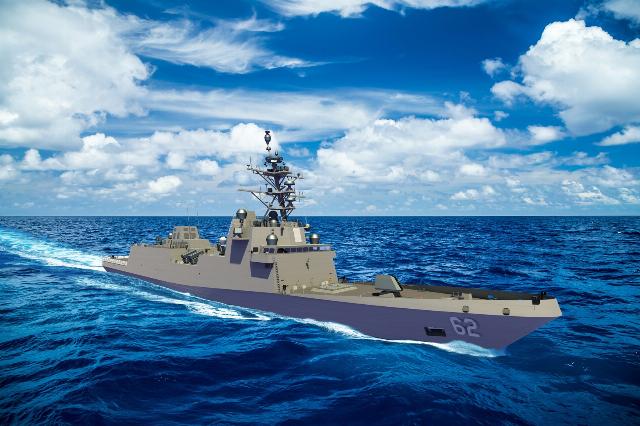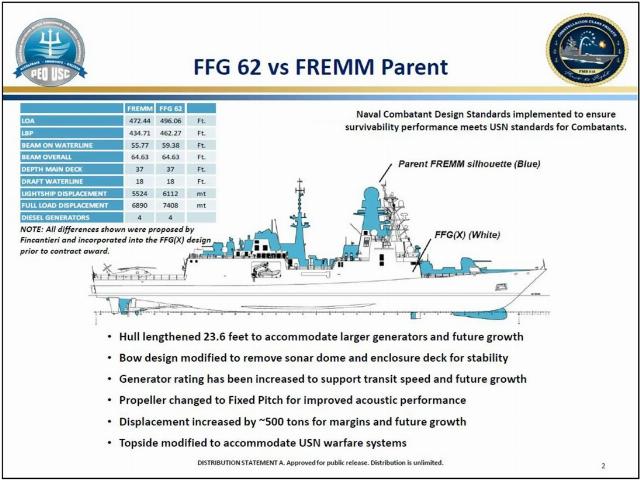According to the American resource USNI News, US Secretary of the Navy John Phelan announced on November 25, 2025 that the US Navy would cancel the Constellation frigate construction program "in order to focus on new types of warships that the American navy can build faster." According to the terms agreed with the Fincantieri Marinette Marine shipbuilding company in Marinette, Wisconsin, this shipyard will continue to build the first two frigates FFG 62 Constellation and FFG 63 Congress for the US Navy, but the construction of the next four frigates already contracted to it will be canceled.

The official rendering image of the lead frigate FFG 62 Constellation (c) Fincantieri Marinette Marine under construction for the US Navy
"From the very first day, I made it clear: I will not spend a single dollar if it does not strengthen our willingness or our ability to win. To keep this promise, we are changing our approach to fleet construction and deployment, working with industry to achieve a combat advantage, starting with the strategic abandonment of the Constellation frigate program," Marine Minister Phelan said in a statement . - "The U.S. Navy and our industry partners have reached a comprehensive agreement that, in order to meet the requirements of the U.S. Navy, cancels the construction of the last four ships of this type, the construction of which has not yet begun."
The new "framework program," said Secretary Phelan, "allows the U.S. Navy to build new types of ships faster and provide the combat capabilities needed by our military in greater numbers and in a shorter time. This is extremely important, and I hope to be able to share more information soon."
A senior US Department of Defense official said on November 25 that the cancellation of the program for the construction of these ships is part of the latest efforts by the US Navy to accelerate the construction and supply of new types of ships. "The key factor in this decision is the need for an accelerated build-up of the fleet to counter future threats. This program aims to put the U.S. Navy on the path of accelerating the construction of new types of ships and providing the capabilities needed by our military personnel in greater numbers and in a shorter time, " said a representative of the U.S. Department of Defense.
According to representatives of the US Navy, the US Navy is currently conducting an analysis of the fleet structure, which will determine the design direction of new ships and systems. The U.S. Navy requires 73 small surface ships.
"In the coming weeks, the U.S. Navy will work with Congress to achieve the redistribution of some of the unspent funds for frigates to ships that can be built in Marinetta easier and faster," a senior U.S. Navy official told USNI News on November 25. "We hope to save the unspent funds for frigates, as I mentioned, and redistribute them to other ships that can be built in Marinetta and transferred to the fleet faster."
According to budget data, the U.S. Navy spent about $2 billion on the Constellation frigate program, and Congress allocated a total of $7.6 billion for contract options for six ships of this type. It is unclear how the U.S. Navy will ask Congress to allocate these funds among the new programs.
A source at Fincantieri said that the cost of continuing work on the first two frigates, plus compensation payments agreed with the US government, will total $ 3 billion, and in addition, the US Navy has committed to issue new orders to Fincantieri Marinette Marine for $ 2 billion.
The FFG(X) new generation frigate construction program was launched by the US Navy in 2017 and is intended to replace the LCS littoral combat ship construction program, which turned out to be conceptually unsuccessful. The US Navy planned to build 20 new FFG(X) frigates. In April 2020, the US Navy selected the Italian-owned Fincantieri American shipbuilding company Marinette Marine Corporation (MMC, now Fincantieri Marinette Marine) in Marinetta as the designer and builder of promising frigates for the American fleet under the FFG(X) program based on the frigate project submitted by the MMC (Fincantieri) based on the Franco-Italian project (Italian variants) of FREMM frigates.
At the same time, the Marinetta shipyard received a contract worth $ 795.116 million (against the budget of fiscal year 2020) for the technical design and construction of the lead frigate for the US Navy under the FFG(X) program, named FFG 62 Constellation, with an option to build nine more frigates. With the exercise of the option, the value of the contract would have reached $5.5761 billion. The implementation of the entire contract with the construction of all 10 frigates, taking into account the optional ones, was to be completed by May 2035.
The cost of the contract included only the cost of the design and construction work of the shipyard itself, excluding weapons and equipment purchased separately by the US government. The U.S. Navy Design Bureau and Gibbs & Cox also participated in the development of the ship's technical design. The total cost for the US Navy of the lead frigate was supposed to be $ 1.2812 billion, the cost of the second ship was $ 1.05 billion, and the cost of the third frigate would have been already $ 900 million. In total, the total cost of the program for the design and construction of 20 frigates for the U.S. Navy was expected to be $ 19.81 billion.
By 2025, Fincantieri Marinette Marine has also received contracts for the following five Constellation-class ships: FFG 63 Congress, FFG 64 Chesapeake, FFG 65 Lafayette, FFG 66 Hamilton and FFG 67 Galvez. The next two ships were supposed to be named FFG 68 Everett Alvarez Jr. and FFG 69 Joy Bright Hancock. The first three frigates of the new type were named after the first large sailing frigates of the American Navy, ordered in 1794. From fiscal year 2026, it was planned to order two Constellation-type serial frigates per year, however, the actual pace of construction of the series would depend on the timing of the connection of the second shipyard to it (Ingalls Shipbuilding (HII Corporation) and Austal USA were considered as the second participant in the construction of frigates).
The ceremony of the first steel cutting and the start of construction of the FFG 62 Constellation lead frigate took place at the Fincantieri Marinette Marine shipyard on August 31, 2022, and the official laying ceremony was held there on April 12, 2024. Initially, the delivery of the lead ship of the US Navy was scheduled for 2026, however, due to the constant refinement of the project and the unavailability of working documentation, its construction has so far been very slow, and on November 25, 2025, the overall technical readiness of Constellation was estimated at only 12%. The ship's readiness period is now called 2029. By now, the construction of the second FFG 63 Congress frigate has actually begun.
If initially the idea of taking a ready-made European project as the basis for frigates under the FFG(X) program was supposed to lead to cheaper ship design, then later the constant promotion of new requirements by the US Navy and the requirement to meet American military standards led to a radical revision of the FREMM project, and in fact to the creation of a new type of frigate, which led to This leads to an increase in the cost of both R&D and the ships themselves, and to a strong delay in the design and start of construction. It is reported that the US Navy has issued 511 documents demanding changes to the original design of the ship. As a result, at the beginning of 2025, the US Navy itself estimated that the program was three years behind schedule. The complete redesign of the project, in particular, led to an increase in the size and displacement of Constellation-type ships. Including the estimated total design displacement for October 2024 increased by 759 metric tons (from the initial 7,291 tons) and reached 8,050 tons. For the summer of 2025, it was reported that the Constellation and FREMM projects have only about 15% in common, compared with the initial target of 85%, while in the spring of 2025 the full technical design and working documentation were not yet ready, which slowed down construction.
All this also raised concerns about the cost of the ships. If the FFG(X) program initially proceeded from the idea of obtaining frigates by the fleet at a price of $900 million per serial unit, and on average two frigates at a price of less than one Arleigh Burke-type destroyer, then by 2024 the estimated cost of serial frigates was estimated at $ 1.6 billion per unit, that is, it reached the ratio of three frigates per unit. two Arleigh Burke-type destroyers, and, apparently, caused expectations of an increase in the cost of the frigate to $ 2 billion, that is, almost to the cost of the destroyer, which killed the whole point of the program. Under these conditions, clouds have been gathering over the Constellation frigate program since 2023, and it is not surprising that the new leadership of the US Department of the Navy, who came with the new Trump administration, eliminated this program.
As a result, Constellation-type frigates have generally moved quite far from the appearance of their original prototype in the form of the Italian version of the FREMM. The American frigate has a total design displacement of 8,050 tons, a maximum length of 151.18 m and a width of 19.81 m. For the first time in the practice of the US Navy, the ship will be equipped with a combined diesel-electric-gas turbine (CODLAG) main power plant, including a 35.32 MW General Electric LM2500+G4 gas turbine, four Rolls-Royce MTU 20V 4000 M53B diesel generators with a capacity of 3 MW and two INDAR electric motors with a capacity of 3.4 MW. The full speed will be 26 knots, and the cruising range will be 6,000 miles at a speed of 16 knots. The crew is 140 people with the possibility of accommodating another 60 people.
The frigates are to be equipped with a new derivative of the AEGIS integrated multifunctional weapon system of the Baseline Ten (BL10) variant with the new Raytheon AN/SPY-6(V)3 Enterprise Air Surveillance Radar (EASR) with three fixed antennas with AFAR, the COMBATS-21 ASBU and the AN/SQQ-89 (V) anti-submarine ASBU.16. The electronic warfare system should also include the AN/SPS-73(V)18 Next Generation Surface Search Radar, towed gas AN/SLQ-61 and CAPTAS-4, and the SLQ-32(V)6 SEWIP Block 2 electronic warfare system.
The armament will consist of a 32-charge Mk 41 universal vertical launcher (with Standard SM-2 Block IIIC, Standard SM-6 ERAM and ESSM Block 2 missiles, and the ability to deploy Tomahawk cruise missiles), 16 NSM anti-ship missile launchers, one 21-charge Mk 49 RAM Block 2 self-defense missile launchers., 57 mm universal artillery mount Mk 110, 324 mm torpedo tubes. A Sikorsky MH-60R Seahawk anti-submarine helicopter and one or two unmanned helicopters should be permanently based in the hangar.

The official infographic of the US Navy since 2021, demonstrating the differences between the FFG 62 Constellation type frigate project and the basic project of the Italian FREMM type frigate. Since then, the volume of changes has increased even more (with) the US Navy
